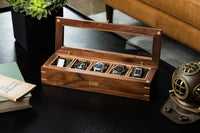So you caught your vintage watch in a door jamb — and your spouse hit you upside the head, because it’s an expensive watch. You look over your precious timepiece and realize, much to your horror, that there’s a scratch in the crystal. What now?
Well, the good news is that you can most likely get that pesky scratch out. But first, you have to figure out what type of crystal your watch uses…
Acrylic Crystals

Rolex GMT-Master 'Pepsi' Ref. 16750 circa 1980s featuring an acrylic crystal.
For much of the 20th century prior to roughly the 1980s, this was the type of crystal used in the watch industry. Inexpensive but fragile, these crystals scratch easily — the good news being that they also buff out easily. Polywatch is a paste that can be purchased for a few bucks on Amazon and used to polish out scratches, though in a pinch, you can also use toothpaste. More on that in a second…
Mineral Crystals

Cartier Ceinture circa 1980's featuring a mineral crystal.
Mineral crystals use a type of glass melted with hardening agents, which yields a product far harder than acrylic. The bad news is that deep scratches in mineral crystals — which are common on inexpensive contemporary watches — are tough to get out. In fact, it’s easier to have a watchmaker swap the crystal out for a fresh one.
Sapphire Crystals

Rolex Submariner Date Two-Tone Ref 16613 circa 1980s featuring a sapphire crystal.
This is the type of crystal affixed to most luxury watches. Sapphire is highly scratch resistant, scoring a 9 out of 10 on the Mohs hardness scale. (Diamond, if you’re wondering, is a 10.) That being said, in the very unlikely even that you somehow manage to scratch your sapphire crystal, don't fret! As with any other crystal, a sapphire can be replaced for a few hundred bucks.
How to Remove Scratches from a Watch Crystal
Step 1: Stock Up
You’re gonna need a few things:
Painter’s tape: This is used to protect the watch bezel.
Polywatch: This mild abrasive will get the scratches out (*You can use toothpaste in a pinch, as it’s also essentially an abrasive paste.)
Cleaning cloth: Use this to apply the Polywatch and buff the crystal.
(Optional) Watch case holder: If you prefer, you can hold the watch case in a holder while you work for easier purchase. Either seat the case holder in a vise on a workbench, or simply hold it in your non-dominant hand.
Step 2: Protect the Watch Bezel
 Take your painter’s tape and apply it to the watch bezel, as you don’t want to cover this part in cleaning paste or potentially scratch it. Your application of tape doesn’t have to be perfect — do the best you can.
Take your painter’s tape and apply it to the watch bezel, as you don’t want to cover this part in cleaning paste or potentially scratch it. Your application of tape doesn’t have to be perfect — do the best you can.
Step 3: Apply Polywatch and Buff
 Add a small amount of Polywatch to the crystal and use the cloth to begin buffing in a circular motion on the scratched part of the crystal. The effects won’t be immediately obvious — you’ll have to do this for several minutes, or multiple times.
Add a small amount of Polywatch to the crystal and use the cloth to begin buffing in a circular motion on the scratched part of the crystal. The effects won’t be immediately obvious — you’ll have to do this for several minutes, or multiple times.
Step 4: Check the Results

On an acrylic crystal, you should begin seeing results within a few minutes. (You may need to continue to buff for longer.) On a mineral crystal, you’ll likely need to work for quite a while — or, if the scratch is deep enough, to simply replace the entire crystal.
 Tip: Polywatch is generally sufficient to remove most surface-level scratches from an acrylic crystal. But if you really want to be sure, you can purchase diamond lapping paste, which is used by jewelers. Try the 3.5µ variety first, then check your results. After this, use the .5µ — the equivalent of a fine-grit sandpaper — to return a nice polish to the crystal.
Tip: Polywatch is generally sufficient to remove most surface-level scratches from an acrylic crystal. But if you really want to be sure, you can purchase diamond lapping paste, which is used by jewelers. Try the 3.5µ variety first, then check your results. After this, use the .5µ — the equivalent of a fine-grit sandpaper — to return a nice polish to the crystal.












